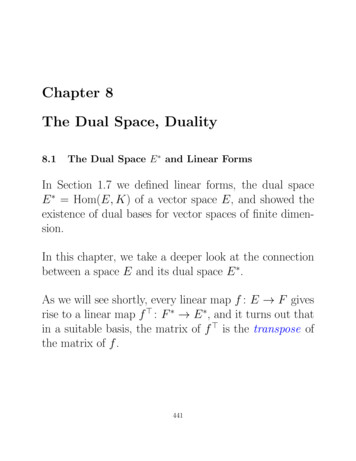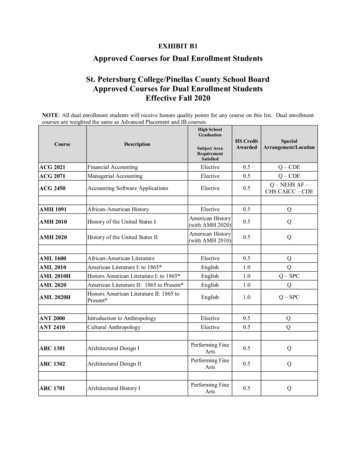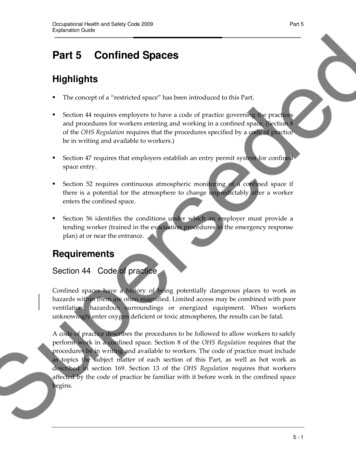
Transcription
Chapter 8The Dual Space, Duality8.1The Dual Space E and Linear FormsIn Section 1.7 we defined linear forms, the dual spaceE Hom(E, K) of a vector space E, and showed theexistence of dual bases for vector spaces of finite dimension.In this chapter, we take a deeper look at the connectionbetween a space E and its dual space E .As we will see shortly, every linear map f : E ! F givesrise to a linear map f : F ! E , and it turns out thatin a suitable basis, the matrix of f is the transpose ofthe matrix of f .441
442CHAPTER 8. THE DUAL SPACE, DUALITYThus, the notion of dual space provides a conceptual explanation of the phenomena associated with transposition.But it does more, because it allows us to view subspacesas solutions of sets of linear equations and vice-versa.Consider the following set of two “linear equations” inR3 ,xxy z 0y z 0,and let us find out what is their set V of common solutions(x, y, z) 2 R3.By subtracting the second equation from the first, we get2z 0, and by adding the two equations, we find that2(x y) 0, so the set V of solutions is given byy xz 0.
8.1. THE DUAL SPACE E AND LINEAR FORMS443This is a one dimensional subspace of R3. Geometrically,this is the line of equation y x in the plane z 0.Now, why did we say that the above equations are linear?This is because, as functions of (x, y, z), both mapsf1 : (x, y, z) 7! x y z and f2 : (x, y, z) 7! x yare linear.zThe set of all such linear functions from R3 to R is a vectorspace; we used this fact to form linear combinations of the“equations” f1 and f2.Observe that the dimension of the subspace V is 1.The ambient space has dimension n 3 and there aretwo “independent” equations f1, f2, so it appears thatthe dimension dim(V ) of the subspace V defined by mindependent equations isdim(V ) nm,which is indeed a general fact (proved in Theorem 8.1).
444CHAPTER 8. THE DUAL SPACE, DUALITYMore generally, in Rn, a linear equation is determined byan n-tuple (a1, . . . , an) 2 Rn, and the solutions of thislinear equation are given by the n-tuples (x1, . . . , xn) 2Rn such thata1x1 · · · anxn 0;these solutions constitute the kernel of the linear map(x1, . . . , xn) 7! a1x1 · · · anxn.The above considerations assume that we are working inthe canonical basis (e1, . . . , en) of Rn, but we can define“linear equations” independently of bases and in any dimension, by viewing them as elements of the vector spaceHom(E, K) of linear maps from E to the field K.
8.1. THE DUAL SPACE E AND LINEAR FORMS445Definition 8.1. Given a vector space E, the vectorspace Hom(E, K) of linear maps from E to K is calledthe dual space (or dual) of E. The space Hom(E, K) isalso denoted by E , and the linear maps in E are calledthe linear forms, or covectors. The dual space E ofthe space E is called the bidual of E.As a matter of notation, linear forms f : E ! K will alsobe denoted by starred symbol, such as u , x , etc.
4468.2CHAPTER 8. THE DUAL SPACE, DUALITYPairing and Duality Between E and E Given a linear form u 2 E and a vector v 2 E, theresult u (v) of applying u to v is also denoted by hu , vi.This defines a binary operation h , i : E E ! Ksatisfying the following properties:hu 1 u 2 , vi hu 1 , vi hu 2 , vihu , v1 v2i hu , v1i hu , v2ih u , vi hu , vihu , vi hu , vi.The above identities mean that h , i is a bilinear map,since it is linear in each argument.It is often called the canonical pairing between E andE.
8.2. PAIRING AND DUALITY BETWEEN E AND E 447In view of the above identities, given any fixed vector v 2E, the map evalv : E ! K (evaluation at v) definedsuch thatevalv (u ) hu , vi u (v) for every u 2 E is a linear map from E to K, that is, evalv is a linearform in E .Again from the above identities, the mapevalE : E ! E , defined such thatevalE (v) evalv for every v 2 E,is a linear map.We shall see that it is injective, and that it is an isomorphism when E has finite dimension.
448CHAPTER 8. THE DUAL SPACE, DUALITYWe now formalize the notion of the set V 0 of linear equations vanishing on all vectors in a given subspace V E,and the notion of the set U 0 of common solutions of agiven set U E of linear equations.The duality theorem (Theorem 8.1) shows that the dimensions of V and V 0, and the dimensions of U and U 0,are related in a crucial way.It also shows that, in finite dimension, the maps V 7! V 0and U 7! U 0 are inverse bijections from subspaces of Eto subspaces of E .
8.2. PAIRING AND DUALITY BETWEEN E AND E 449Definition 8.2. Given a vector space E and its dual E ,we say that a vector v 2 E and a linear form u 2 E are orthogonal i hu , vi 0. Given a subspace V ofE and a subspace U of E , we say that V and U areorthogonal i hu , vi 0 for every u 2 U and everyv 2 V . Given a subset V of E (resp. a subset U of E ),the orthogonal V 0 of V is the subspace V 0 of E definedsuch thatV 0 {u 2 E hu , vi 0, for every v 2 V }(resp. the orthogonal U 0 of U is the subspace U 0 of Edefined such thatU 0 {v 2 E hu , vi 0, for every u 2 U }).The subspace V 0 E is also called the annihilator ofV.
450CHAPTER 8. THE DUAL SPACE, DUALITYThe subspace U 0 E annihilated by U E does nothave a special name. It seems reasonable to call it thelinear subspace (or linear variety) defined by U .Informally, V 0 is the set of linear equations that vanishon V , and U 0 is the set of common zeros of all linearequations in U . We can also define V 0 byV 0 {u 2 E V Ker u }and U 0 by0U \Ker u .u 2UObserve that E 0 {0} (0), and {0}0 E .Furthermore, if V1 V2 E, then V20 V10 E , andif U1 U2 E , then U20 U10 E.
8.2. PAIRING AND DUALITY BETWEEN E AND E 451It can also be shown that that V V 00 for every subspace V of E, and that U U 00 for every subspace U ofE .We will see shortly that in finite dimension, we haveV V 00 and U U 00.Here are some examples. Let E M2(R), the space ofreal 2 2 matrices, and let V be the subspace of M2(R)spanned by the matrices 0 11 00 0,,.1 00 00 1We check immediately that the subspace V consists of allmatrices of the form b a,a cthat is, all symmetric matrices.
452CHAPTER 8. THE DUAL SPACE, DUALITYThe matrices a11 a12a21 a22 in V satisfy the equationa12a21 0,and all scalar multiples of these equations, so V 0 is thesubspace of E spanned by the linear form given byu (a11, a12, a21, a22) a12a21.By the duality theorem (Theorem 8.1) we havedim(V 0) dim(E)dim(V ) 43 1.The above example generalizes to E Mn(R) for anyn 1, but this time, consider the space U of linear formsasserting that a matrix A is symmetric; these are thelinear forms spanned by the n(n 1)/2 equationsaijaji 0,1 i j n;
8.2. PAIRING AND DUALITY BETWEEN E AND E 453Note there are no constraints on diagonal entries, and halfof the equationsaijaji 0,1 i 6 j nare redundant. It is easy to check that the equations(linear forms) for which i j are linearly independent.To be more precise, let U be the space of linear forms inE spanned by the linear formsu ij (a11, . . . , a1n, a21, . . . , a2n, . . . , an1, . . . , ann) aij aji, 1 i j n.The dimension of U is n(n 1)/2. Then, the set U 0 ofcommon solutions of these equations is the space S(n) ofsymmetric matrices.By the duality theorem (Theorem 8.1), this space hasdimensionn(n 1) n22n(n1)2.
454CHAPTER 8. THE DUAL SPACE, DUALITYIf E Mn(R), consider the subspace U of linear formsin E spanned by the linear formsu ij (a11, . . . , a1n, a21, . . . , a2n, . . . , an1, . . . , ann) aij aji, 1 i j nu ii(a11, . . . , a1n, a21, . . . , a2n, . . . , an1, . . . , ann) aii, 1 i n.It is easy to see that these linear forms are linearly independent, so dim(U ) n(n 1)/2.The space U 0 of matrices A 2 Mn(R) satifying all of theabove equations is clearly the space Skew(n) of skewsymmetric matrices.By the duality theorem (Theorem 8.1), the dimension ofU 0 isn(n1)2 n2n(n 1).2
8.2. PAIRING AND DUALITY BETWEEN E AND E 455For yet another example with E Mn(R), for any A 2Mn(R), consider the linear form in E given bytr(A) a11 a22 · · · ann,called the trace of A.The subspace U 0 of E consisting of all matrices A suchthat tr(A) 0 is a space of dimension n2 1.The dimension equationsdim(V ) dim(V 0) dim(E)dim(U ) dim(U 0) dim(E)are always true (if E is finite-dimensional). This is partof the duality theorem (Theorem 8.1).In constrast with the previous examples, given a matrixA 2 Mn(R), the equations asserting that A A I arenot linear constraints.
456CHAPTER 8. THE DUAL SPACE, DUALITYFor example, for n 2, we havea211 a221 1a221 a222 1a11a12 a21a22 0.Given a vector space E and any basis (ui)i2I for E, wecan associate to each ui a linear form u i 2 E , and theu i have some remarkable properties.Definition 8.3. Given a vector space E and any basis(ui)i2I for E, by Proposition 1.11, for every i 2 I, thereis a unique linear form u i such that 1 if i ju i (uj ) 0 if i 6 j,for every j 2 I. The linear form u i is called the coordinate form of index i w.r.t. the basis (ui)i2I .
8.2. PAIRING AND DUALITY BETWEEN E AND E 457The reason for the terminology coordinate form was explained in Section 1.7.We proved in Theorem 1.14 that if (u1, . . . , un) is a basisof E, then (u 1 , . . . , u n) is a basis of E called the dualbasis.If (u1, . . . , un) is a basis of Rn (more generally K n), itis possible to find explicitly the dual basis (u 1 , . . . , u n),where each u i is represented by a row vector.
458CHAPTER 8. THE DUAL SPACE, DUALITYFor example, consider the01B0B4 B@00columns of the Bézier matrix13 3136 3CC.0 33A0 0 1The form u 1 is represented by a row vector (such that123401234)11 3 31B0 36 3CBC 1 0 0 0 .@0 0 33A0 0 0 1This implies that u 1 is the first row of the inverse of B4.
8.2. PAIRING AND DUALITY BETWEEN E AND E 459SinceB4 101B0 B@0011/30012/31/30111CC,1A1the linear forms (u 1 , u 2 , u 3 , u 4 ) correspond to the rows ofB4 1 .In particular, u 1 is represented by (1 1 1 1).The above method works for any n. Given any basis(u1, . . . , un) of Rn, if P is the n n matrix whose jthcolumn is uj , then the dual form u i is given by the ithrow of the matrix P 1.We have the following important duality theorem adaptedfrom E. Artin.
4608.3CHAPTER 8. THE DUAL SPACE, DUALITYThe Duality TheoremTheorem 8.1. (Duality theorem) Let E be a vectorspace of dimension n. The following properties hold:(a) For every basis (u1, . . . , un) of E, the family of coordinate forms (u 1 , . . . , u n) is a basis of E .(b) For every subspace V of E, we have V 00 V .(c) For every pair of subspaces V and W of E suchthat E V W , with V of dimension m, for everybasis (u1, . . . , un) of E such that (u1, . . . , um) is abasis of V and (um 1, . . . , un) is a basis of W , thefamily (u 1 , . . . , u m) is a basis of the orthogonal W 0of W in E . Furthermore, we have W 00 W , anddim(W ) dim(W 0) dim(E).(d) For every subspace U of E , we havedim(U ) dim(U 0) dim(E),where U 0 is the orthogonal of U in E, andU 00 U .
8.3. THE DUALITY THEOREM461Part (a) of Theorem 8.1 shows thatdim(E) dim(E ),and if (u1, . . . , un) is a basis of E, then (u 1 , . . . , u n) isa basis of the dual space E called the dual basis of(u1, . . . , un).Define the function E (E for equations) from subspacesof E to subspaces of E and the function Z (Z for zeros)from subspaces of E to subspaces of E byE(V ) V 0,Z(U ) U 0,V EU E .By part (c) and (d) of theorem 8.1,(Z E)(V ) V 00 V(E Z)(U ) U 00 U,so Z E id and E Z id, and the maps E and V areinverse bijections.
462CHAPTER 8. THE DUAL SPACE, DUALITYThese maps set up a duality between subspaces of E, andsubspaces of E . One should be careful that this bijection does not holdif E has infinite dimension. Some restrictions on thedimensions of U and V are needed.Suppose that V is a subspace of Rn of dimension m andthat (v1, . . . , vm) is a basis of V .To find a basis of V 0, we first extend (v1, . . . , vm) to abasis (v1, . . . , vn) of Rn, and then by part (c) of Theorem 8.1, we know that (vm 1, . . . , vn ) is a basis of V 0.For example, suppose that V is the subspace of R4 spannedby the two linearly independent vectors0 10 111B1 CB1CBCC,v1 @ A v2 B@ 1A111the first two vectors of the Haar basis in R4.
8.3. THE DUALITY THEOREMThe four columns of the Haar01 1B1 1W B@1 11 1463matrix11 01 0CC0 1A01form a basis of R4, and the inverse of W is given by011/4 1/4 1/4 1/4B1/4 1/41/4 1/4C1BC.W @1/2 1/2 00 A001/21/2Since the dual basis (v1 , v2 , v3 , v4 ) is given by the row ofW 1, the last two rows of W 1, 1/2 1/2 00,00 1/2 1/2form a basis of V 0.
464CHAPTER 8. THE DUAL SPACE, DUALITYWe also obtain a basis by rescaling by the factor 1/2, sothe linear forms given by the row vectors 1 1 0 00 0 1 1form a basis of V 0, the space of linear forms (linear equations) that vanish on the subspace V .The method that we described to find V 0 requires firstextending a basis of V and then inverting a matrix, butthere is a more direct method.
8.3. THE DUALITY THEOREM465Indeed, let A be the n m matrix whose columns arethe basis vectors (v1, . . . , vm) of V . Then, a linear formu represented by a row vector belongs to V 0 i uvi 0for i 1, . . . , m i uA 0i A u 0.Therefore, all we need to do is to find a basis of thenullspace of A .This can be done quite e ectively using the reduction ofa matrix to reduced row echelon form (rref); see Section5.9.
466CHAPTER 8. THE DUAL SPACE, DUALITYHere is another example illustrating the power of Theorem 8.1.Let E Mn(R), and consider the equations assertingthat the sum of the entries in every row of a matrix A 2Mn(R) is equal to the same number.We have nnXj 11 equations(aijai 1j ) 0,1 i n1,and it is easy to see that they are linearly independent.Therefore, the space U of linear forms in E spanned bythe above linear forms (equations) has dimension n 1,and the space U 0 of matrices sastisfying all these equations has dimension n2 n 1.It is not so obvious to find a basis for this space.
8.3. THE DUALITY THEOREM467When E is of finite dimension n and (u1, . . . , un) is abasis of E, we noted that the family (u 1 , . . . , u n) is abasis of the dual space E ,Let us see how the coordinates of a linear form ' 2 E over the basis (u 1 , . . . , u n) vary under a change of basis.Let (u1, . . . , un) and (v1, . . . , vn) be two bases of E, andlet P (ai j ) be the change of basis matrix from (u1, . . . , un)to (v1, . . . , vn), so thatvj nXai j u i .i 1If' nX'iu i i 1i 1after some algebra, we get'0j nXnXi 1ai j ' i .'0ivi ,
468CHAPTER 8. THE DUAL SPACE, DUALITYComparing with the change of basisvj nXai j u i ,i 1we note that this time, the coordinates ('i) of the linearform ' change in the same direction as the change ofbasis.For this reason, we say that the coordinates of linear formsare covariant.By abuse of language, it is often said that linear formsare covariant, which explains why the term covector isalso used for a linear form.Observe that if (e1, . . . , en) is a basis of the vector spaceE, then, as a linear map from E to K, every linear formf 2 E is represented by a 1 n matrix, that is, by arow vector( 1 · · · n),with respect to the basis (e1, . . . , en) of E, and 1 of K,where f (ei) i.
8.3. THE DUALITY THEOREM469PA vector u ni 1 uiei 2 E is represented by a n 1matrix, that is, by a column vector0 1u1@ . A ,unand the action of f on u, namely f (u), is represented bythe matrix product0 1u1@ . A 1u1 · · · nun.1 ···nunOn the other hand, with respect to the dual basis (e 1 , . . . , e n)of E , the linear form f is represented by the column vector0 11@ . A .n
470CHAPTER 8. THE DUAL SPACE, DUALITYWe will now pin down the relationship between a vectorspace E and its bidual E .Proposition 8.2. Let E be a vector space. The following properties hold:(a) The linear map evalE : E ! E defined such thatevalE (v) evalv ,for all v 2 E,that is, evalE (v)(u ) hu , vi u (v) for everyu 2 E , is injective.(b) When E is of finite dimension n, the linear mapevalE : E ! E is an isomorphism (called thecanonical isomorphism).When E is of finite dimension and (u1, . . . , un) is a basisof E, in view of the canonical isomorphism evalE : E ! E , the basis (u 1 , . . . , un ) of the bidual isidentified with (u1, . . . , un).Proposition 8.2 can be reformulated very fruitfully interms of pairings.
8.3. THE DUALITY THEOREM471Definition 8.4. Given two vector spaces E and F overK, a pairing between E and F is a bilinear map' : E F ! K. Such a pairing is nondegenerate i (1) for every u 2 E, if '(u, v) 0 for all v 2 F , thenu 0, and(2) for every v 2 F , if '(u, v) 0 for all u 2 E, thenv 0.A pairing ' : E F ! K is often denoted byh , i : E F ! K.For example, the map h , i : E E ! K definedearlier is a nondegenerate pairing (use the proof of (a) inProposition 8.2).Given a pairing ' : E F ! K, we can define two mapsl' : E ! F and r' : F ! E as follows:
472CHAPTER 8. THE DUAL SPACE, DUALITYFor every u 2 E, we define the linear form l'(u) in F such thatl'(u)(y) '(u, y) for every y 2 F ,and for every v 2 F , we define the linear form r'(v) inE such thatr'(v)(x) '(x, v) for every x 2 E.Proposition 8.3. Given two vector spaces E and Fover K, for every nondegenerate pairing' : E F ! K between E and F , the mapsl' : E ! F and r' : F ! E are linear and injective. Furthermore, if E and F have finite dimension,then this dimension is the same and l' : E ! F andr' : F ! E are bijections.When E has finite dimension, the nondegenerate pairing h , i : E E ! K yields another proof of theexistence of a natural isomorphism between E and E .Interesting nondegenerate pairings arise in exterior algebra.
8.3. THE DUALITY THEOREMME,-rt Ie.473C l-O C KFigure 8.1: Metric Clock
4748.4CHAPTER 8. THE DUAL SPACE, DUALITYHyperplanes and Linear FormsActually, Proposition 8.4 below follows from parts (c) and(d) of Theorem 8.1, but we feel that it is also interestingto give a more direct proof.Proposition 8.4. Let E be a vector space. The following properties hold:(a) Given any nonnull linear form f 2 E , its kernelH Ker f is a hyperplane.(b) For any hyperplane H in E, there is a (nonnull)linear form f 2 E such that H Ker f .(c) Given any hyperplane H in E and any (nonnull)linear form f 2 E such that H Ker f , forevery linear form g 2 E , H Ker g i g f for some 6 0 in K.We leave as an exercise the fact that every subspaceV 6 E of a vector space E, is the intersection of allhyperplanes that contain V .We now consider the notion of transpose of a linear mapand of a matrix.
8.5. TRANSPOSE OF A LINEAR MAP AND OF A MATRIX8.5475Transpose of a Linear Map and of a MatrixGiven a linear map f : E ! F , it is possible to define amap f : F ! E which has some interesting properties.Definition 8.5. Given a linear map f : E ! F , thetranspose f : F ! E of f is the linear map definedsuch thatf (v ) v f,for every v 2 F , as shown in the diagram below:fE CCCCCC CC!f (v )/F v K.Equivalently, the linear map f : F ! E is definedsuch thathv , f (u)i hf (v ), ui,for all u 2 E and all v 2 F .
476CHAPTER 8. THE DUAL SPACE, DUALITYIt is easy to verify that the following properties hold: (f g) f g (g f ) f g id E idE .Note the reversal of composition on the right-hand sideof (g f ) f g .The equation (g f ) f useful proposition.g implies the followingProposition 8.5. If f : E ! F is any linear map,then the following properties hold:(1) If f is injective, then f is surjective.(2) If f is surjective, then f is injective.
8.5. TRANSPOSE OF A LINEAR MAP AND OF A MATRIX477We also have the following property showing the naturality of the eval map.Proposition 8.6. For any linear map f : E ! F , wehavef evalE evalFf,or equivalently, the following diagram commutes:EO f /F O evalEEevalFf/F.
478CHAPTER 8. THE DUAL SPACE, DUALITYIf E and F are finite-dimensional, then evalE and evalFare isomorphisms, so Proposition 8.6 shows thatf evalF 1 fevalE .( )The above equation is often interpreted as follows: if weidentify E with its bidual E and F with its bidual F ,then f f .This is an abuse of notation; the rigorous statement is( ).Proposition 8.7. Given a linear map f : E ! F , forany subspace V of E, we havef (V )0 (f ) 1(V 0) {w 2 F f (w ) 2 V 0}.As a consequence,Ker f (Im f )0andKer f (Im f )0.
8.5. TRANSPOSE OF A LINEAR MAP AND OF A MATRIX479The following theorem shows the relationship between therank of f and the rank of f .Theorem 8.8. Given a linear map f : E ! F , thefollowing properties hold.(a) The dual (Im f ) of Im f is isomorphic toIm f f (F ); that is,(Im f ) Im f .(b) If F is finite dimensional, then rk(f ) rk(f ).The following proposition can be shown, but it requires ageneralization of the duality theorem.Proposition 8.9. If f : E ! F is any linear map,then the following identities hold:Im f (Ker (f ))0Ker (f ) (Im f )0Im f (Ker (f )0Ker (f ) (Im f )0.
480CHAPTER 8. THE DUAL SPACE, DUALITYThe following proposition shows the relationship betweenthe matrix representing a linear map f : E ! F and thematrix representing its transpose f : F ! E .Proposition 8.10. Let E and F be two vector spaces,and let (u1, . . . , un) be a basis for E, and (v1, . . . , vm)be a basis for F . Given any linear map f : E ! F ,if M (f ) is the m n-matrix representing f w.r.t.the bases (u1, . . . , un) and (v1, . . . , vm), the n mmatrix M (f ) representing f : F ! E w.r.t. the dual bases (v1 , . . . , vm) and (u 1 , . . . , u n) is the transpose M (f ) of M (f ).We now can give a very short proof of the fact that therank of a matrix is equal to the rank of its transpose.Proposition 8.11. Given a m n matrix A over afield K, we have rk(A) rk(A ).Thus, given an m n-matrix A, the maximum numberof linearly independent columns is equal to the maximumnumber of linearly independent rows.
8.5. TRANSPOSE OF A LINEAR MAP AND OF A MATRIX481Proposition 8.12. Given any m n matrix A over afield K (typically K R or K C), the rank of A isthe maximum natural number r such that there is aninvertible r r submatrix of A obtained by selectingr rows and r columns of A.For example, the 3 2 matrix01a11 a12A @a21 a22Aa31 a32has rank 2 i one of the three 2 2 matrices a11 a12a11 a12a21 a22a21 a22a31 a32a31 a32is invertible. We saw in Chapter 4 that this is equivalentto the fact the determinant of one of the above matricesis nonzero.This is not a very efficient way of finding the rank ofa matrix. We will see that there are better ways usingvarious decompositions such as LU, QR, or SVD.
482CHAPTER 8. THE DUAL SPACE, DUALITYOF IH1S.1 S IHkf rf '5 OAJL'f OFIMPoRTArJc.E:., AND 1FfE:RE. IS NO WAyrf cAN SS or MY pgAC:lltAL use.\\Figure 8.2: Beauty
8.6. THE FOUR FUNDAMENTAL SUBSPACES8.6483The Four Fundamental SubspacesGiven a linear map f : E ! F (where E and F arefinite-dimensional), Proposition 8.7 revealed that the fourspacesIm f, Im f , Ker f, Ker f play a special role. They are often called the fundamentalsubspaces associated with f .These spaces are related in an intimate manner, sinceProposition 8.7 shows thatKer f (Im f )0Ker f (Im f )0,and Theorem 8.8 shows thatrk(f ) rk(f ).
484CHAPTER 8. THE DUAL SPACE, DUALITYIt is instructive to translate these relations in terms ofmatrices (actually, certain linear algebra books make abig deal about this!).If dim(E) n and dim(F ) m, given any basis (u1, . . .,un) of E and a basis (v1, . . . , vm) of F , we know that f isrepresented by an m n matrix A (ai j ), where the jthcolumn of A is equal to f (uj ) over the basis (v1, . . . , vm).Furthermore, the transpose map f is represented by then m matrix A (with respect to the dual bases).Consequently, the four fundamental spacesIm f, Im f , Ker f, Ker f correspond to
8.6. THE FOUR FUNDAMENTAL SUBSPACES485(1) The column space of A, denoted by Im A or R(A);this is the subspace of Rm spanned by the columns ofA, which corresponds to the image Im f of f .(2) The kernel or nullspace of A, denoted by Ker A orN (A); this is the subspace of Rn consisting of allvectors x 2 Rn such that Ax 0.(3) The row space of A, denoted by Im A or R(A );this is the subspace of Rn spanned by the rows of A,or equivalently, spanned by the columns of A , whichcorresponds to the image Im f of f .(4) The left kernel or left nullspace of A denoted byKer A or N (A ); this is the kernel (nullspace) of A ,the subspace of Rm consisting of all vectors y 2 Rmsuch that A y 0, or equivalently, y A 0.Recall that the dimension r of Im f , which is also equalto the dimension of the column space Im A R(A), isthe rank of A (and f ).
486CHAPTER 8. THE DUAL SPACE, DUALITYThen, some our previous results can be reformulated asfollows:1. The column space R(A) of A has dimension r.2. The nullspace N (A) of A has dimension n3. The row space R(A ) has dimension r.r.4. The left nullspace N (A ) of A has dimension mr.The above statements constitute what Strang calls theFundamental Theorem of Linear Algebra, Part I (seeStrang [32]).
8.6. THE FOUR FUNDAMENTAL SUBSPACES487The two statementsKer f (Im f )0Ker f (Im f )0translate to(1) The nullspace of A is the orthogonal of the row spaceof A.(2) The left nullspace of A is the orthogonal of the columnspace of A.The above statements constitute what Strang calls theFundamental Theorem of Linear Algebra, Part II (seeStrang [32]).Since vectors are represented by column vectors and linearforms by row vectors (over a basis in E or F ), a vectorx 2 Rn is orthogonal to a linear form y ifyx 0.
488CHAPTER 8. THE DUAL SPACE, DUALITYThen, a vector x 2 Rn is orthogonal to the row space ofA i x is orthogonal to every row of A, namelyAx 0, which is equivalent to the fact that x belong tothe nullspace of A.Similarly, the column vector y 2 Rm (representing alinear form over the dual basis of F ) belongs to thenullspace of A i A y 0, i y A 0, which meansthat the linear form given by y (over the basis in F ) isorthogonal to the column space of A.Since (2) is equivalent to the fact that the column spaceof A is equal to the orthogonal of the left nullspace ofA, we get the following criterion for the solvability of anequation of the form Ax b:The equation Ax b has a solution i for all y 2 Rm, ifA y 0, then y b 0.
8.6. THE FOUR FUNDAMENTAL SUBSPACES489Indeed, the condition on the right-hand side says that bis orthogonal to the left nullspace of A, that is, that bbelongs to the column space of A.This criterion can be cheaper to check that checking directly that b is spanned by the columns of A. For example, if we consider the systemx1x2x3x 2 b1x 3 b2x 1 b3which, in matrix form, is written Ax b as below:010 1 0 111 0x1b1@0 11 A @x 2 A @b 2 A ,1 0 1x3b3we see that the rows of the matrix A add up to 0.
490CHAPTER 8. THE DUAL SPACE, DUALITYIn fact, it is easy to convince ourselves that the left nullspaceof A is spanned by y (1, 1, 1), and so the system is solvable i y b 0, namelyb1 b2 b3 0.Note that the above criterion can also be stated negativelyas follows:The equation Ax b has no solution i there is somey 2 Rm such that A y 0 and y b 6 0.
8.6. THE FOUR FUNDAMENTAL SUBSPACESat.!( /I' /II -'leJ'1 II - i(p:, - PI) A491dX)2eVh'--- --Figure 8.3: Brain Size?
492CHAPTER 8. THE DUAL SPACE, DUALITY
The matrices a 11 a 12 a 21 a 22 in V satisfy the equation a 12 a 21 0, and all scalar multiples of these equations, so V0 is the subspace of E spanned by the linear form given by u (a 11,a 12,a 21,a 22) a 12 a 21. By the duality theorem (Theorem 8.1) we have dim(V0) dim(E)dim











